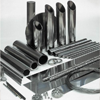Внимание: осторожно мошенники!
От имени Чепецкого механического завода в адрес предприятий и организаций стали приходить поддельные документы (срочные уведомления, заявки на аукционы и т.п.).
Неизвестные лица рассылают фиктивные заявки о проведении аукционов (например, на право заключения договора поставки нержавеющего металлопроката для нужд АО ЧМЗ). При этом, мошенники используют подложные бланки, несуществующую печать АО ЧМЗ, ставят поддельные подписи действующих сотрудников коммерческой службы, а также подписываются сотрудниками вымышленных отделов (например, отдел закупок срочных аукционов АО ЧМЗ).
Официально заявляем, что Чепецкий механический завод к такого рода документам не имеет никакого отношения.
Убедительно просим проверять поступающую документацию, якобы направленную от имени АО ЧМЗ. Для проверки информации необходимо связываться с официальными коммерческими службами Чепецкого механического завода по тел. (341-41) 9-64-22.
Пример поддельного документа
Rosatom starts construction of unique power unit with BREST-OD-300 fast neutron reactor
08.06.2021
The construction of a 300 MW nuclear power unit enabled with the innovative BREST-OD-300 lead-cooled fast reactor has begun at the site of the Siberian Chemical Combine (an enterprise of Rosatom-subsidiary TVEL Fuel Company) in Seversk, Russia’s Tomsk region (South-West Siberia). The reactor will run on mixed uranium-plutonium nitride fuel (MNUP fuel), specially developed for this facility (it is considered to be the optimal solution for fast reactors).
The power plant will make up an integral part of the Pilot Demonstration Energy Complex (PDEC) – a cluster of three interconnected unique facilities, including the nuclear fuel production plant (for fabrication and refabrication), the BREST-OD-300 power unit, and the facility for irradiated fuel reprocessing. For the first time in history, a nuclear power plant powered by a fast reactor will be built alongside closed nuclear fuel cycle servicing enterprises on one site. After reprocessing, the irradiated fuel from the reactor will be sent for refabrication (i.e. reproduction into fresh fuel), thereby giving this system the means to gradually become practically autonomous and independent of external resources supplies. PDEC is constructed in the framework of Rosatom’s “Breakthough” project, aimed at development of the new technological platform for the nuclear industry.
“The nuclear power industry’s resource base will practically become inexhaustible thanks to the infinite reprocessing of nuclear fuel. At the same time, the future generations will be spared the problem of accumulating spent nuclear fuel. The successful implementation of this project will allow our country to become the world’s first owner of the nuclear power technology which fully meets the principles of sustainable development in terms of environment, accessibility, reliability, and efficient use of resources. Today, we reaffirm our reputation as a leader in world progress in the nuclear technologies, that offers humanity unique solutions aimed at improving people’s lives,” said Alexey Likhachev, Director General of Rosatom.
The design of the BREST-OD-300 lead-cooled reactor is based on the principles of so-called natural safety. The features of the reactor made it possible to abandon the melt trap, a large volume of support systems, and also to lower the safety class of the non-reactor equipment. The integral design and physics of the reactor facility make enable to exclude accidents requiring evacuation of the population. In the future, such installations should not only enhance the safety of nuclear power, but also make it more economically competitive in comparison with the most efficient thermal power generation (in particular, steam-gas technology).
“The implementation of the ‘Breakthrough’ project embraces not just development of innovative reactors, but also introduction of the new generation technologies of nuclear fuel cycle. Firstly, this includes production of dense nitride MNUP fuel, which will ensure the efficient operation of a lead-cooled fast reactor and consist entirely of recycled nuclear materials such as plutonium and depleted uranium. Secondly, this means more efficient and economically attractive radiochemical technologies for the processing of irradiated fuel and waste management. Taken together, they will make the nuclear power of the future in fact renewable with a practically waste-free production chain,” said Natalia Nikipelova, President of Rosatom’s TVEL Fuel Company.
Rosatom Director General Alexey Likhachev, Tomsk regional governor Sergei Zhvachkin, Kurchatov Institute President Mikhail Kovalchuk, IAEA Director General Rafael Grossi, and other Russian and non-Russian guests attended the event. Russian Academy of Sciences President Alexander Sergeev and OECD Nuclear Energy Agency (OECD NEA) Director General William Magwood sent in video addresses.
According to the planned timeline, the BREST-OD-300 reactor should start operating in 2026. A fuel production facility will be built by 2023 and the construction of an irradiated fuel reprocessing module is scheduled to start by 2024.
About Rosatom
ROSATOM is a diversified holding that unites assets in the energy sector, the mechanical engineering industry, and the construction industry. Its objective is to develop low-carbon sources of energy, including wind energy. ROSATOM is Russia’s national leader in electricity generation (producing over 20% of the country’s total power) and ranks first in the world in terms of portfolio of foreign projects, with 35 power units at different stages of implementation in 12 countries. ROSATOM is the only company in the world that has competencies in the entire technological chain of the nuclear fuel cycle, from natural uranium mining to the final stages of a nuclear facility’s lifespan. The scope of ROSATOM’s activity also extends to scientific research, the development of the Northern Sea Route, the development of various innovative products, both nuclear and non-nuclear, and environmental projects, including the creation of eco-technology parks and a state system for handling hazardous industrial waste. ROSATOM employs over 260,000 people in more than 400 enterprises and organisations.
About BREST-OD-300
The advantage of fast reactors is their ability to efficiently use the fuel cycle’s secondary byproducts (in particular, plutonium) for energy production. At the same time as having a high regeneration factor, fast reactors can produce more potential fuel than they consume and also burn out (i.e. use in the process of energy generation) highly active transuranic elements (actinides).
The BREST-OD-300 reactor will provide itself with its main energy component – plutonium-239 – reproducing it from the isotope uranium-238, which has a relative abundance of more than 99% (it is the isotope uranium-235, which makes about 0.7% of natural uranium, that is currently used to produce energy in thermal reactors). The introduction of such technologies will increase exponentially the efficiency of natural uranium. Uranium has about a 86% share in the world reserves of energy resources, compared to coal at 8%, oil at 3%, and gas at 3%.
The experimental demonstration power complex is being built within the framework of Rosatom’s strategic project “Breakthrough,” (Proryv) which is aimed at creating a new technological platform for nuclear energy. Russia’s strategy in the sector entails the creation of a two-component nuclear power industry with thermal and fast neutron reactors and a closed nuclear fuel cycle. This envisages the widespread introduction of technologies for the recycling of nuclear materials, which would not only make it possible to expand the nuclear power industry’s raw material base many times over, but also solve the problem of accumulating spent fuel and nuclear waste, i.e. it would reuse SNF products instead of storing them and radically reduce the volume of waste generation in the industry.
Просмотров: 373







